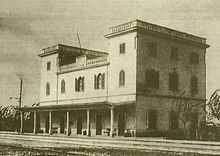Barca
Barce (sometimes Barca) (Greek: Βάρκη, Arabic: برقة, Berber: Berqa) was an ancient Greek colony and later Roman, Byzantine, city in North Africa. It occupied the coastal area of what is modern day Libya. As a Greek city it was part of the Cyrenaican Pentapolis along with the city of Cyrene itself.
According to most archeologists, it was situated at Marj, but according to Alexander Graham at Tolmeitha (Ptolemais).[1]
The city's name, Arabized as Barqah, came to refer to the former state and province of Cyrenaica.[2]
History

Early Christianity spread to the Pentapolis of North Africa from Egypt. Synesius of Cyrene (370–414 AD), bishop of Ptolemais, received his instruction at Alexandria in both the Catechetical School and the Museion, and he entertained a great deal of reverence and affection for Hypatia, the last pagan Neoplatonists, whose classes he had attended. Synesius was raised to the episcopate by Theophilus, patriarch of Alexandria, in 410. Since the Council of Nicaea in 325, Cyrenaica had been recognized as an ecclesiastical province of the See of Alexandria, in accordance with the ruling of the Nicaean Fathers. The patriarch of the Coptic Church to his day includes the Pentapolis in his title as an area within his jurisdiction.[3]
After often being destroyed and then restored, during the Roman period it became a mere borough but was, nevertheless, the site of a bishopric. Its bishop, Zopyros, was present at the First Council of Nicaea in 325.[4] The subscriptions at Ephesus (431) and Chalcedon (451) give the names of two other bishops, Zenobius and Theodorus.
Barce was part of the Exarchate of Africa until it was conquered by the Arabs in 643–644 during the Islamic conquest of North Africa. It originally served as the capital of the Barqah province of the Caliphate. When the Ottoman Turks conquered the region in 1521 they used the Turkish form "Barka" for the province, but did not retain the city's status as its capital.
During World War II, a battle for Barce of the North African campaign was won on 5 February 1941 by the 1st Field Regiment, Royal Australian Artillery. The regiment remembers this battle through the naming of its facilities at its base at Enoggera, Barce Lines.
The modern city on the same site, Marj, grew up around a 19th-century Turkish fort. It was developed by the Italians during their colonial dominance of Libya and today has a population of 120,000. The Italian settlement was severely damaged in a 1963 earthquake and is now largely abandoned. No remains of the ancient settlement are visible, but some of the finds made during the Italian period are on display in the museum at nearby Ptolemais.
Ecclesiastical history
Barca is now a Roman Catholic titular see of Cyrenaica in Libya, Northern Africa, but vacant. The Eparchy of the Western Pentapolis was part of the Coptic Orthodox Church of Alexandria as the Pope of Alexandria was the Pope of Africa, the most senior position in The Holy Synod of the Coptic Orthodox Church after the Pope was the Metropolitan of Western Pentapolis, but since its demise in the days of Pope John VI of Alexandria as a major Archiepiscopal Metropolis and now being held as a Titular See attached to another Diocese.
Sources and references
| Wikisource has the text of the 1911 Encyclopædia Britannica article Barca. |
-
 "Barca". Catholic Encyclopedia. New York: Robert Appleton Company. 1913.
"Barca". Catholic Encyclopedia. New York: Robert Appleton Company. 1913. - GigaCatholic – Titular sees
- Butler, The Arab Conquest of Egypt, p. 430
- Heinrich Gelzer, Patrum Nicaenorum nomina, p. 231
- Marquardt, Staatsverwaltung, I, p. 459
- Westermann, Großer Atlas zur Weltgeschichte (in German)
References
- ↑ Graham, Alexander (1902) Roman Africa: an outline of the history of the Roman occupation of North Africa, based chiefly upon inscriptions and monumental remains in that country Longmans, Green, and Co., London, p. 312, OCLC 2735641
- ↑ "Barce" Encyclopædia Britannica (1964 edition) p. 153
- ↑ Atiya, Aziz S. "The Copts and Christian Civilization" Coptic.net, accessed 19 May 2009
- ↑ "Barca" The Catholic Encyclopedia (1907) Robert Appleton Company, New York
See also
Coordinates: 32°29′54″N 20°53′34″E / 32.49833°N 20.89278°E